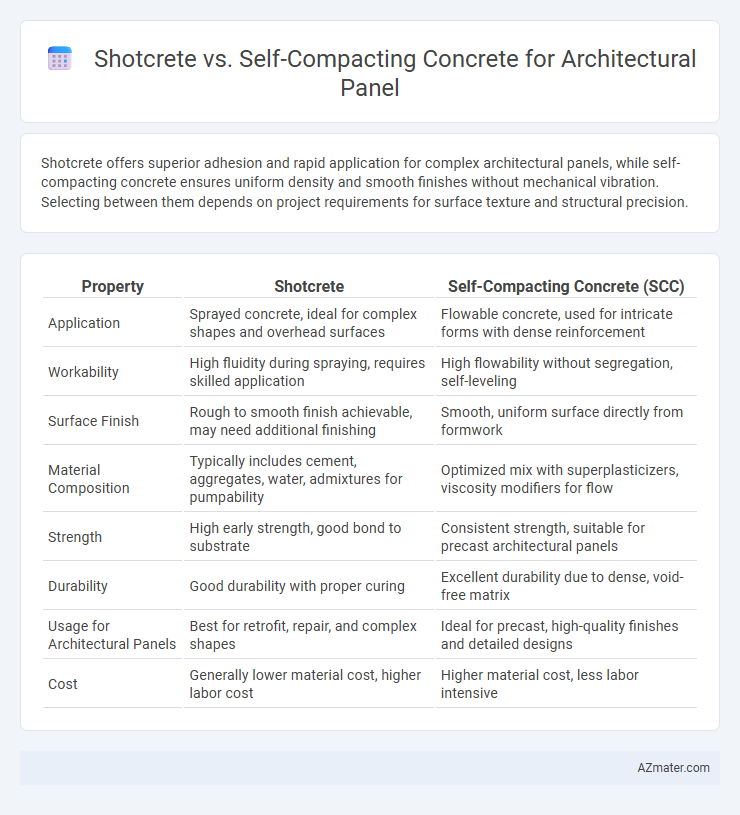Shotcrete offers superior adhesion and rapid application for complex architectural panels, while self-compacting concrete ensures uniform density and smooth finishes without mechanical vibration. Selecting between them depends on project requirements for surface texture and structural precision.
Table of Comparison
| Property | Shotcrete | Self-Compacting Concrete (SCC) |
|---|---|---|
| Application | Sprayed concrete, ideal for complex shapes and overhead surfaces | Flowable concrete, used for intricate forms with dense reinforcement |
| Workability | High fluidity during spraying, requires skilled application | High flowability without segregation, self-leveling |
| Surface Finish | Rough to smooth finish achievable, may need additional finishing | Smooth, uniform surface directly from formwork |
| Material Composition | Typically includes cement, aggregates, water, admixtures for pumpability | Optimized mix with superplasticizers, viscosity modifiers for flow |
| Strength | High early strength, good bond to substrate | Consistent strength, suitable for precast architectural panels |
| Durability | Good durability with proper curing | Excellent durability due to dense, void-free matrix |
| Usage for Architectural Panels | Best for retrofit, repair, and complex shapes | Ideal for precast, high-quality finishes and detailed designs |
| Cost | Generally lower material cost, higher labor cost | Higher material cost, less labor intensive |
Introduction to Architectural Panels
Architectural panels require materials that combine structural integrity with aesthetic appeal, making Shotcrete and Self-compacting Concrete (SCC) prominent choices. Shotcrete offers high adaptability for complex shapes and rapid application, while SCC provides superior flowability, ensuring uniform surface finishes critical for architectural precision. Selecting between these materials depends on panel complexity, finish requirements, and installation efficiency in construction projects.
Overview of Shotcrete
Shotcrete is a pneumatically applied concrete that offers high adhesion and rapid setting, making it ideal for complex architectural panels with intricate shapes. Its ability to be applied vertically or overhead without formwork reduces construction time and material waste. The dense, durable finish achieved by shotcrete provides enhanced structural integrity and surface uniformity, crucial for aesthetic and functional architectural elements.
Overview of Self-Compacting Concrete (SCC)
Self-Compacting Concrete (SCC) is a highly flowable, non-segregating concrete that can spread into formwork and encapsulate reinforcement without mechanical vibration, making it ideal for complex architectural panels. SCC's superior workability enhances surface finish quality and dimensional accuracy, reducing labor costs and improving durability compared to traditional cast-in-place methods like shotcrete. Its optimized mix design includes fine powders, superplasticizers, and viscosity-modifying agents to maintain stability and flowability, ensuring precision in intricate architectural applications.
Material Composition and Properties
Shotcrete for architectural panels typically consists of a mixture containing cement, aggregates, water, and admixtures applied pneumatically, offering high adhesion and rapid setting properties ideal for complex surface shapes. Self-compacting concrete (SCC) features a highly flowable, viscous mix with optimized fine and coarse aggregates, superplasticizers, and viscosity-modifying agents, enabling it to fill intricate formwork without vibration, resulting in smooth, defect-free finishes. Material composition of SCC ensures superior workability and uniformity, while shotcrete's mechanical properties provide superior bonding strength, making the choice dependent on panel complexity and desired surface texture.
Application Methods: Shotcrete vs SCC
Shotcrete is applied by pneumatically projecting concrete at high velocity onto surfaces, making it ideal for complex shapes and vertical or overhead panels in architectural projects requiring strong adhesion and minimal formwork. Self-compacting concrete (SCC) flows under its own weight without mechanical vibration, allowing for smooth, defect-free finishes in intricately detailed architectural panels with congested reinforcement. The choice between shotcrete and SCC depends on site accessibility, desired surface finish, and structural requirements, with shotcrete suited for repair and sculptural applications and SCC preferred for precision casting and repetitive panel production.
Surface Finish and Aesthetic Quality
Shotcrete offers a textured, rugged surface finish ideal for organic or sculptural architectural panels, with rapid application enabling intricate shapes and detailed textures. Self-compacting concrete provides a smooth, uniform surface with high aesthetic quality, minimizing the need for surface finishing due to its flowable, vibration-free placing characteristics that reduce surface defects. The choice depends on design intent: shotcrete excels in expressive, textured appearances, while self-compacting concrete ensures sleek, flawless finishes for modern architectural panels.
Structural Performance and Durability
Shotcrete offers superior adhesion and rapid application for complex architectural panels, enhancing structural performance in curved or irregular forms. Self-compacting concrete provides uniform density and reduced voids, resulting in high durability and excellent surface finish on flat panels. Both materials exhibit strong compressive strength, but shotcrete's versatile application suits intricate designs while self-compacting concrete excels in consistent quality and long-term durability.
Design Flexibility and Customization
Shotcrete offers high design flexibility for architectural panels due to its ability to conform to complex shapes and textures, ideal for sculptural or curved surfaces. Self-compacting concrete provides superior customization in surface finish and uniformity, enabling precise replication of intricate molds and patterns with fewer defects. Both materials enhance architectural panel aesthetics but differ in application techniques and finish control, influencing project-specific design strategies.
Cost Analysis and Project Efficiency
Shotcrete offers lower material and equipment costs compared to self-compacting concrete (SCC) for architectural panels, reducing initial project expenses. SCC enhances project efficiency through faster placement and superior surface finish, minimizing labor time and rework despite higher material costs. Evaluating overall project budgets reveals that choosing SCC can offset costs by accelerating project timelines and improving panel quality, while shotcrete is preferred for budget-sensitive applications requiring robustness over aesthetics.
Sustainability and Environmental Impact
Shotcrete and self-compacting concrete (SCC) offer distinct sustainability benefits for architectural panels, with SCC reducing material waste and improving worksite efficiency due to its high flowability and minimal vibration requirements. Shotcrete's pneumatic application method allows for reduced formwork and lower water usage, contributing to energy savings during construction. Both materials support environmentally responsible building practices by enabling precise placement and durability, thus extending the lifecycle and reducing the carbon footprint of architectural panels.

Infographic: Shotcrete vs Self-compacting Concrete for Architectural Panel
 azmater.com
azmater.com